
The Wirral Railway was a railway network in the northern part of the Wirral Peninsula, England. Its route was from Birkenhead Park in the east of the Wirral to West Kirby in the west. A branch off this line at Bidston went north to Secombe and New Brighton. It was incorporated in 1863 as the Hoylake Railway, running from Hoylake to Birkenhead Docks. After changes of name and of ownership, it was purchased by the Wirral Railway Company Limited in 1884. The network was extended to West Kirby, New Brighton, and Seacombe, and to Birkenhead Park station where it joined the Mersey Railway, enabling through trains through the Mersey Railway Tunnel to Liverpool. In the 1923 grouping the Wirral company became part of the London, Midland and Scottish Railway, which electrified the line in 1938, allowing passenger services to be integrated with the Liverpool urban system. Most of the Wirral Railway network is still in use today as part of the Wirral Line of the Merseyrail rail network.

The Wirral line is one of two commuter rail routes operated by Merseyrail and centred on Merseyside, England, the other being the Northern line.

The Chester–Birkenhead line runs from Chester to Birkenhead via Hooton. Today, it forms part of the Wirral Line network, a commuter rail system operated by Merseyrail. The line was built by the Chester and Birkenhead Railway and opened on 23 September 1840. On 22 July 1847 the railway merged with the Birkenhead, Lancashire and Cheshire Junction Railway which was later renamed to Birkenhead Railway.

West Kirby railway station serves the town of West Kirby in Merseyside, England. The station is the terminus of the West Kirby branch line, which is one of the two branches of the Wirral Line on the Merseyrail network. There is a central island platform between two terminus tracks and two parallel sidings for out-of-use electric multiple units. A second station, which was the terminus of a branch line from Hooton, lay to the east of the Wirral Line station; it was closed in 1962.
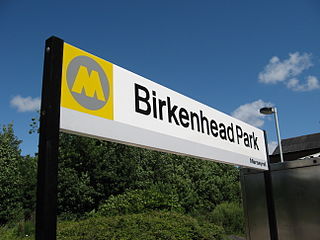
Birkenhead Park railway station is a station serving the town of Birkenhead, in Merseyside, England. It lies on the Wirral Line of the Merseyrail network.

The Shrewsbury and Birmingham Railway was authorised in 1846. It agreed to joint construction with others of the costly Wolverhampton to Birmingham section, the so-called Stour Valley Line. This work was dominated by the hostile London and North Western Railway, which used underhand and coercive tactics. The section between Shrewsbury and Wellington was also built jointly, in this case with the Shropshire Union Railway.

Chester railway station is located in Newtown, Chester, England. Services are operated by Avanti West Coast, Merseyrail, Northern and Transport for Wales. From 1875 to 1969, the station was known as Chester General to distinguish it from Chester Northgate. The station's Italianate frontage was designed by the architect Francis Thompson.

Hooton railway station is situated in the south of the Wirral Peninsula, Cheshire, England. It lies on the Wirral Line 8 miles (13 km) north of Chester and 9+1⁄2 miles (15.3 km) south west of Liverpool Lime Street on the Merseyrail network, and is the junction of the branch from the Chester line to Ellesmere Port. It serves the villages of Hooton and Willaston.

Birkenhead Woodside was a railway station at Woodside, in Birkenhead, on the Wirral Peninsula, Cheshire. It was served by local services in Cheshire as well as long-distance services to southern England, including London.
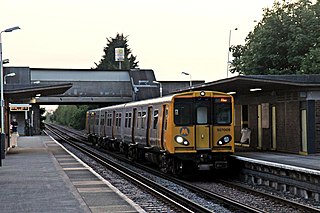
Moreton railway station serves the town of Moreton, in Merseyside, England. The station is on the West Kirby branch of the Wirral Line, which is part of the Merseyrail network.
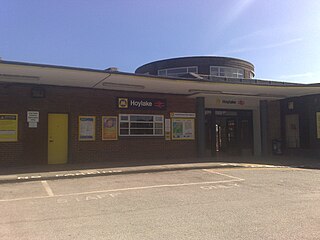
Hoylake railway station serves the town of Hoylake, Merseyside, England. It lies on the West Kirby branch of the Wirral Line, part of the Merseyrail network.

Hadlow Road railway station is a Grade II listed heritage railway station and museum in Willaston, on the Wirral Way footpath. It has been restored to have the look and feel of the day the station was permanently closed to passengers in 1956. It has an authentic ticket office, waiting room and telephone box. Formerly the museum was a working railway station on the single track Hooton to West Kirby branch of the Birkenhead Railway, on the Wirral Peninsula, Cheshire. The station is owned by Cheshire West and Chester Council, and Friends of Hadlow Road Station (FHRS) help to maintain and develop the station as a community resource.
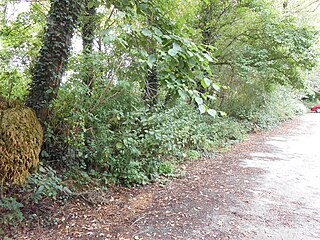
Caldy railway station was a station on the single track Hooton to West Kirby branch of the Birkenhead Railway, on the Wirral Peninsula, England.

Kirby Park railway station was a station on the single track Hooton to West Kirby branch of the Birkenhead Railway, on the Wirral Peninsula, England.

Birkenhead Dock Branch is a disused railway line running from the South junction of Rock Ferry, to the site of the former Bidston Dock on the Wirral Peninsula, England. The branch is approximately 4+1⁄2 miles (7.2 km) in length. Although called a branch, the line was accessible from both ends, from Bidston East junction and from Rock Ferry railway station. The former Mollington Street Rail Depot was branched into the line. A section of the line runs through Haymarket Tunnel and a low-level cutting through the centre of Birkenhead; visible from the road flyovers. The former Canning Street North signal box has now been demolished following fire damage, and the rails across the level crossing there have been removed due to the provision of cycle lanes on the roadway. The non-standard gates remain on the east side, but a fence has been erected on the other side despite the railway being officially out of use, rather than closed. Level crossings are also located at Duke Street and Wallasey Bridge Road. The railway lines are still partially intact.

Thurstaston railway station was a station on the single track Hooton to West Kirby branch of the Birkenhead Railway, on the Wirral Peninsula, England. The station served the village of Thurstaston situated to the north east.

Parkgate railway station was a station on the single track Hooton to West Kirby branch of the Birkenhead Railway, on the Wirral Peninsula, Cheshire, England. The station served the village of Parkgate.
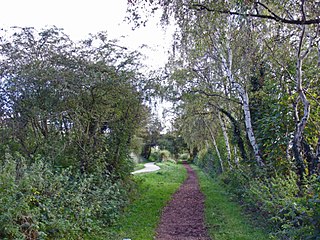
Neston South railway station was a station on the single track Hooton to West Kirby branch of the Birkenhead Railway, on the Wirral Peninsula, Cheshire, England. The station served the town of Neston.

Saltney was a minor railway station located on the Great Western Railway's Paddington to Birkenhead line a few miles west of Chester, England. Although the station is now closed, the route is still open today as part of the Shrewsbury to Chester Line.

The North Wales Mineral Railway was formed to carry coal and ironstone from the mineral-bearing area around Wrexham to the River Dee wharves. It was extended to run from Shrewsbury and formed part of a main line trunk route, under the title The Shrewsbury and Chester Railway. It opened in 1846 from Chester to Ruabon, and in 1848 from Ruabon to Shrewsbury. It later merged with the Great Western Railway.




















